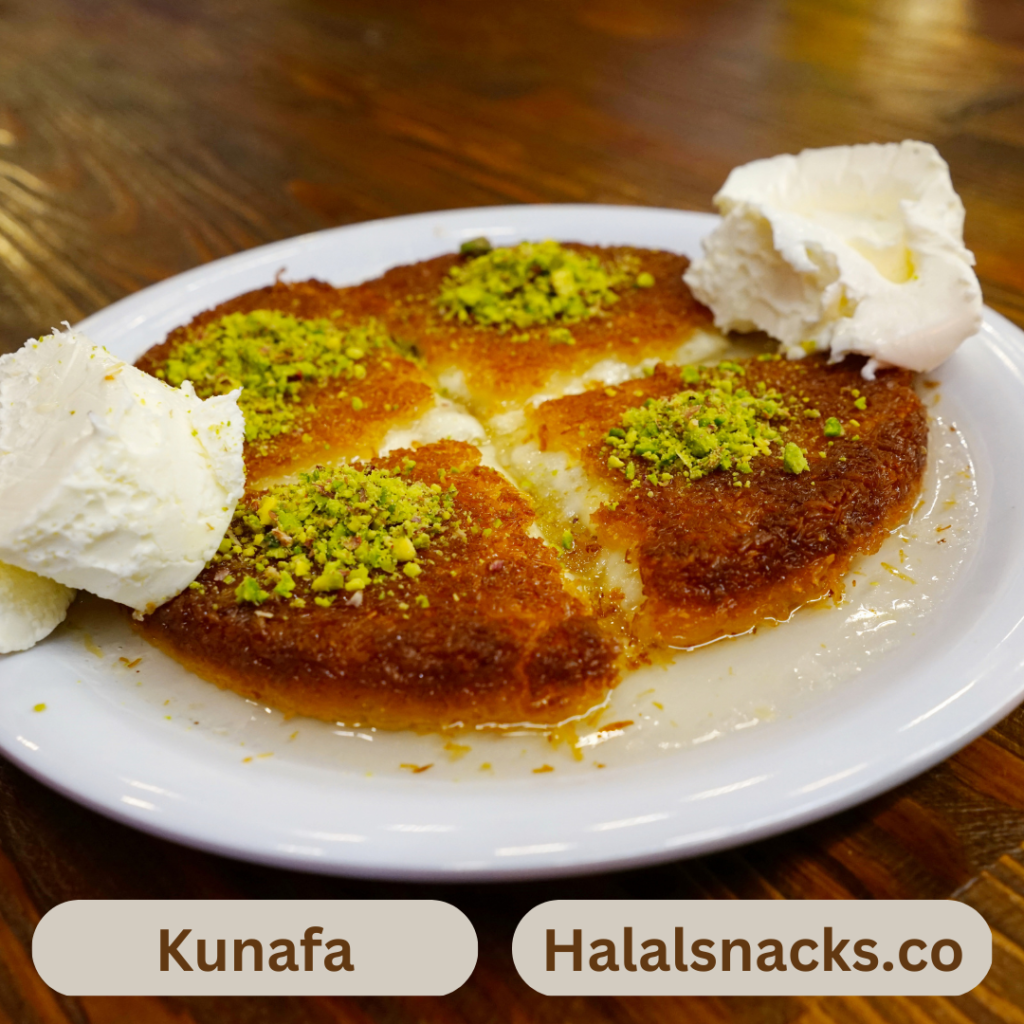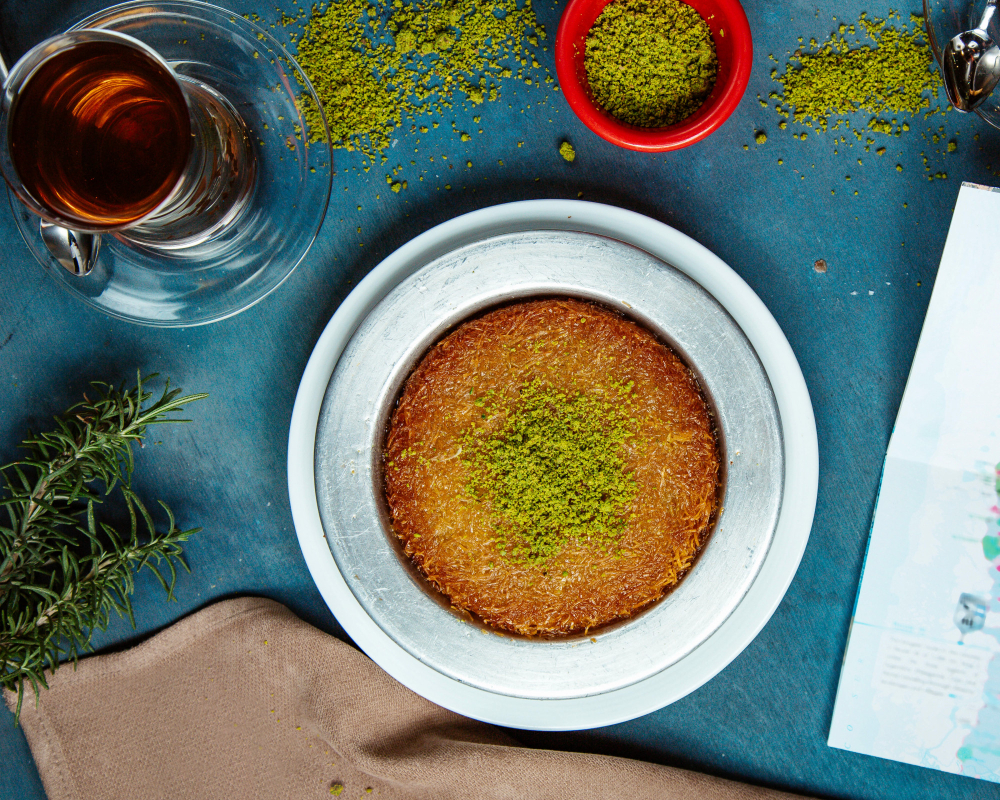If you’re a fan of Middle Eastern cuisine, you’ve probably heard of Kunafa. This sweet and savory treat has been a favorite dessert in the region for centuries, and for good reason. Kunafa is a unique and delicious dessert that’s perfect for satisfying your sweet tooth, and it’s also a popular dish to serve on special occasions.
Table of Contents
- What is Kunafa?
- The Origins of Kunafa
- Ingredients Used in Kunafa
- How is Kunafa Made?
- Different Types of Kunafa
- Tips for Making Kunafa at Home
- Health Benefits of Kunafa
- Conclusion
- FAQs
In this article, we’ll take a closer look at Kunafa, including its origins, ingredients, and how it’s made. We’ll also explore some of the different types of Kunafa that are available and share some tips on how you can make this delectable dessert at home.
What is Kunafa?
Kunafa is a Middle Eastern dessert that is made with shredded phyllo dough, sweet cheese, sugar syrup, and melted butter. The shredded phyllo dough is known as Kataifi, and it’s typically layered with sweet cheese, such as ricotta or mozzarella, before being baked until golden brown.
Once the Kunafa is removed from the oven, it’s drizzled with sugar syrup and topped with pistachios or other nuts. The end result is a sweet and savory dessert that’s crispy on the outside and creamy on the inside.
The Origins of Kunafa
The exact origins of Kunafa are unclear, but it’s believed to have originated in the Levant region, which includes Syria, Lebanon, Jordan, and Palestine. Kunafa has been a popular dessert in the region for centuries and is often served during special occasions, such as weddings and religious holidays.
Today, Kunafa is enjoyed around the world and has become a popular dessert in many Middle Eastern restaurants.

Ingredients Used in Kunafa
The ingredients used in Kunafa can vary slightly depending on the recipe and the region. However, the basic ingredients typically include:
- Shredded phyllo dough (Kataifi)
- Sweet cheese, such as ricotta or mozzarella
- Sugar syrup
- Melted butter
- Pistachios or other nuts for topping
Some variations of Kunafa may also include other ingredients, such as orange blossom water, rose water, or semolina.
How is Kunafa Made?
Kunafa is made by layering shredded phyllo dough with sweet cheese and then baking it in the oven until it’s golden brown. Once it’s removed from the oven, it’s drizzled with sugar syrup and topped with pistachios or other nuts.
To make Kunafa at home, you’ll need to start by preparing the shredded phyllo dough. You can find pre-made Kataifi in some Middle Eastern grocery stores, or you can make it yourself by shredding phyllo dough with a knife or food processor.
Next, you’ll need to prepare the sweet cheese filling by mixing together ricotta cheese or mozzarella cheese with a little sugar and some orange blossom water or rose water.
Once you have your shredded phyllo dough and sweet cheese filling, you can begin layering them in a baking dish. Brush each layer with melted butter, and continue layering until you’ve used all of your ingredients.
Bake the Kunafa in the oven at 350 degrees Fahrenheit for about 30-40 minutes, or until it’s golden brown. Once it’s done, remove it from the oven and drizzle it with sugar syrup before topping it with pistachio.
Different Types of Kunafa
There are several different types of Kunafa, each with its own unique twist on the classic recipe. Here are a few of the most popular types of Kunafa:
- Cheese Kunafa: This is the most common type of Kunafa, and it’s made with sweet cheese, sugar syrup, and pistachios. Some recipes may also include rose water or orange blossom water for added flavor.
- Nutella Kunafa: This is a modern twist on the classic Kunafa, and it’s made with Nutella spread instead of sweet cheese. The Nutella is sandwiched between layers of Kataifi, and it’s baked until crispy and golden brown.
- Cream Kunafa: This type of Kunafa is made with a creamy filling, such as vanilla pudding or whipped cream. It’s often topped with fresh fruit or berries for added flavor.
- Savory Kunafa: While most Kunafa is sweet, there are some savory variations that are worth trying. Savory Kunafa may be made with ground meat, spinach, or other vegetables and spices.
Tips for Making Kunafa at Home
If you’re interested in making Kunafa at home, there are a few tips you should keep in mind:
- Use fresh ingredients: For the best results, be sure to use fresh phyllo dough and cheese. This will ensure that your Kunafa has a crispy texture and delicious flavor.
- Be patient: Making Kunafa can be a bit time-consuming, so be sure to give yourself plenty of time to prepare and bake it.
- Use a quality baking dish: A good-quality baking dish will ensure that your Kunafa bakes evenly and doesn’t stick to the bottom of the pan.
- Don’t skip the sugar syrup: The sugar syrup is what gives Kunafa its signature sweet flavor, so be sure to drizzle it generously over the top of your baked Kunafa.
Health Benefits of Kunafa
While Kunafa is certainly a delicious dessert, it’s not exactly a health food. However, there are a few potential health benefits to consider:
- Phyllo dough is lower in calories than some other types of pastry dough, such as puff pastry.
- Pistachios, which are often used as a topping for Kunafa, are a good source of protein and healthy fats.
- Some types of Kunafa may include ingredients like orange blossom water or rose water, which may have some health benefits, such as reducing stress and promoting relaxation.
Conclusion
Kunafa is a delicious and unique dessert that’s sure to satisfy your sweet tooth. Whether you’re enjoying it at a Middle Eastern restaurant or making it at home, Kunafa is a treat that’s worth trying at least once. With a crispy exterior, creamy interior, and sweet syrupy topping, Kunafa is sure to become one of your new favorite desserts.
FAQs
- Is Kunafa a healthy dessert? Kunafa is not exactly a health food, but it does have a few potential health benefits, such as the use of lower calorie phyllo dough and the inclusion of healthy nuts like pistachios.
- What type of cheese is used in Kunafa? Kunafa is typically made with sweet cheese, such as ricotta or mozzarella.
- Can I make Kunafa at home? Yes, you can make Kunafa at home with a few basic ingredients and some patience. Be sure to follow a good recipe and use fresh ingredients for the best results.
- Is Kunafa only a dessert? While Kunafa is typically a sweet dessert, there are some savory variations that are worth trying, such as those made with ground meat or vegetables.
- Where can I find Kunafa? Kunafa can be found in many Middle Eastern and Mediterranean restaurants, as well as some specialty bakeries. It’s also possible to make Kunafa at home if you have access to the necessary ingredients and equipment.
- How long does Kunafa stay fresh? Kunafa is best enjoyed fresh, but it can be stored in an airtight container in the refrigerator for a day or two. To reheat, simply place it in the oven or microwave until warm.
- Is Kunafa gluten-free? No, Kunafa is not gluten-free as it’s typically made with phyllo dough, which contains gluten.
- What other desserts are similar to Kunafa? There are a few other desserts that are similar to Kunafa, such as baklava, which is also made with phyllo dough and syrup, and qatayef, which is a stuffed pastry similar to a pancake.
- Can I use different types of cheese in Kunafa? Yes, you can experiment with different types of cheese in Kunafa, but be sure to choose a cheese that has a similar texture to sweet cheese, such as ricotta or mozzarella.
- Is Kunafa a traditional dessert? Yes, Kunafa is a traditional dessert that’s popular in many Middle Eastern and Mediterranean countries. It’s often served during holidays and special occasions.










